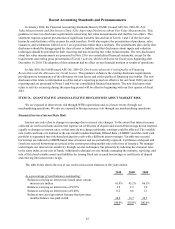Cabela's 2010 Annual Report Download - page 81
Download and view the complete annual report
Please find page 81 of the 2010 Cabela's annual report below. You can navigate through the pages in the report by either clicking on the pages listed below, or by using the keyword search tool below to find specific information within the annual report.71
CABELA’S INCORPORATED AND SUBSIDIARIES
NOTES TO CONSOLIDATED FINANCIAL STATEMENTS
(Dollars in Thousands Except Share and Per Share Amounts)
1. NATURE OF BUSINESS AND SUMMARY OF SIGNIFICANT ACCOUNTING POLICIES
Nature of Business – Cabela’s Incorporated is a retailer of hunting, fishing, and outdoor gear, offering
products through retail stores, the Internet, and regular and special catalog mailings. Cabela’s operates 31 retail
stores, 30 located in 22 states and one located in Winnipeg, Manitoba. World’s Foremost Bank (“WFB”), a wholly-
owned bank subsidiary of Cabela’s, is a limited purpose bank formed under the Competitive Equality Banking Act
of 1987. The lending activities of WFB are limited to credit card lending and its deposit issuance is limited to time
deposits of at least one hundred thousand dollars.
Principles of Consolidation – The consolidated financial statements include the accounts of Cabela’s
Incorporated and its wholly-owned subsidiaries (“Cabela’s,” “Company,” “we,” “our,” or “us”). All material
intercompany accounts and transactions have been eliminated in consolidation. The guidance of Accounting
Standards Codification (“ASC”) Topics 810, Consolidations, and 860, Transfers and Servicing, resulted in the
consolidation of the Cabela’s Master Credit Card Trust and related entities (collectively referred to as the “Trust”)
effective January 3, 2010. The consolidation of the Trust eliminated retained interests in securitized loans and
required the establishment of an allowance for loan losses on the securitized credit card loans. The credit card
loans of the Trust are recorded as restricted credit card loans and the liabilities of the Trust are recorded as secured
borrowings. The secured borrowings still contain the legal isolation requirements which would protect the assets
pledged as collateral for the securitization investors as well as protecting Cabela’s and WFB from any liability
from default on the notes. In 2010, Cabela’s began reporting the results of operations of the Company’s Financial
Services business in a manner similar to its historical managed presentation for financial performance of the total
managed portfolio of credit card loans, excluding income derived from the changes in the valuation of our interest-
only strip, cash reserve accounts, and cash accounts associated with the securitized loans.
Evaluation of Subsequent Events – Management of the Company evaluated subsequent events through the
filing date of this Form 10-K and determined that there were no subsequent events to recognize or disclose in the
consolidated financial statements presented herein.
Reporting Year – The Company’s fiscal year ends on the Saturday nearest to December 31. Unless otherwise
stated, the fiscal years referred to in the notes to these consolidated financial statements are the 52 weeks ended
January 1, 2011 (“2010” or “year ended 2010”), the 53 weeks ended January 2, 2010 (“2009” or “year ended 2009”),
and the 52 weeks ended December 27, 2008 (“2008” or “year ended 2008”). WFB follows a calendar fiscal period
and, accordingly, fiscal years end on December 31st. Fiscal 2010 consisted of 52 weeks and fiscal 2009 consisted of
53 weeks. The effect of the extra week in 2009 on total revenues was an increase of $51,444.
Use of Estimates – The preparation of financial statements in conformity with accounting principles
generally accepted in the United States of America requires management to make estimates and assumptions that
affect the reported amounts of assets and liabilities and disclosure of contingent assets and liabilities at the date
of the financial statements and the reported amounts of revenue and expenses during the reporting period. Actual
results could differ from those estimates.
Revenue Recognition – Revenue is recognized for retail store sales at the time of the sale in the store and for
Direct sales when the merchandise is delivered to the customer. The Company recognizes a reserve for estimated
product returns based on our historical returns experience. Shipping fees charged to customers are included in net
revenue and shipping costs are included in cost of revenue.
























